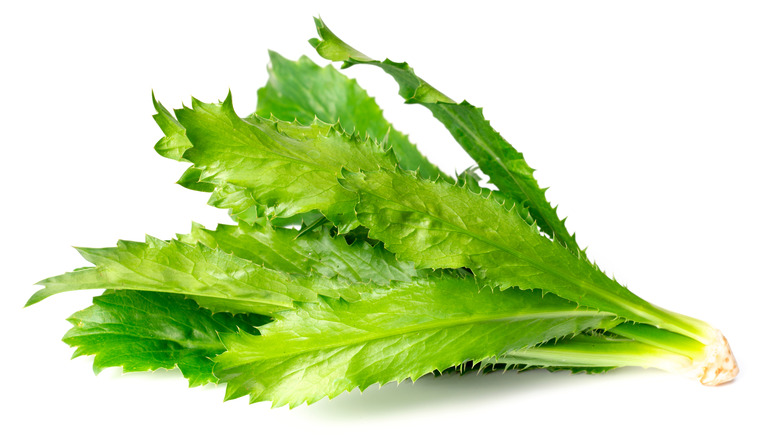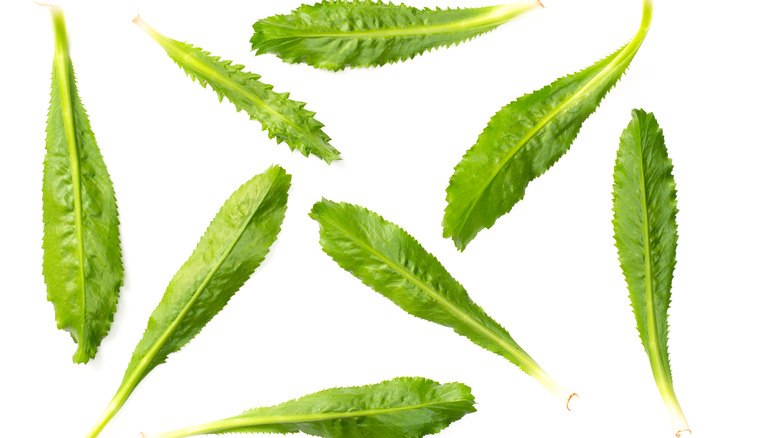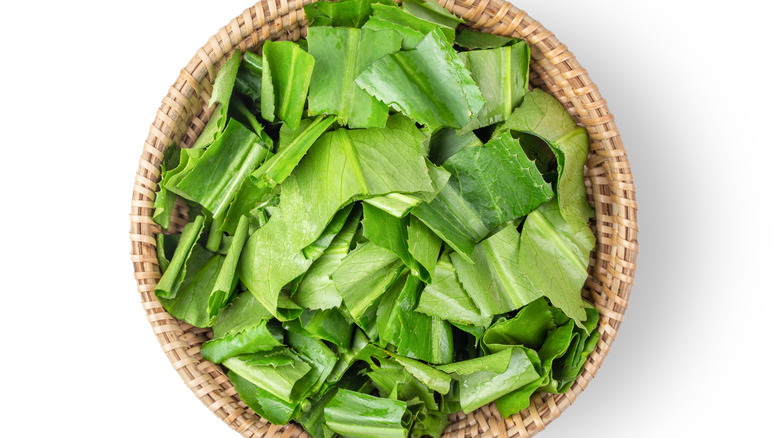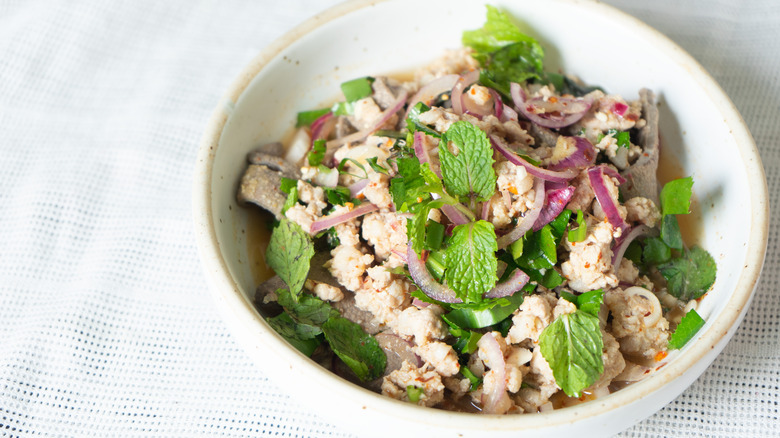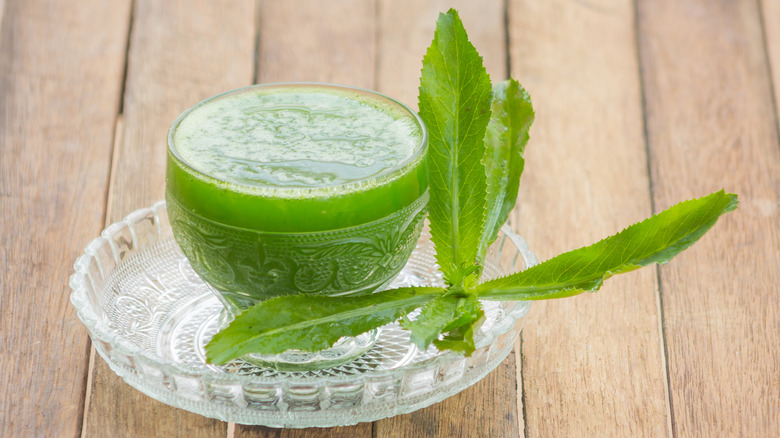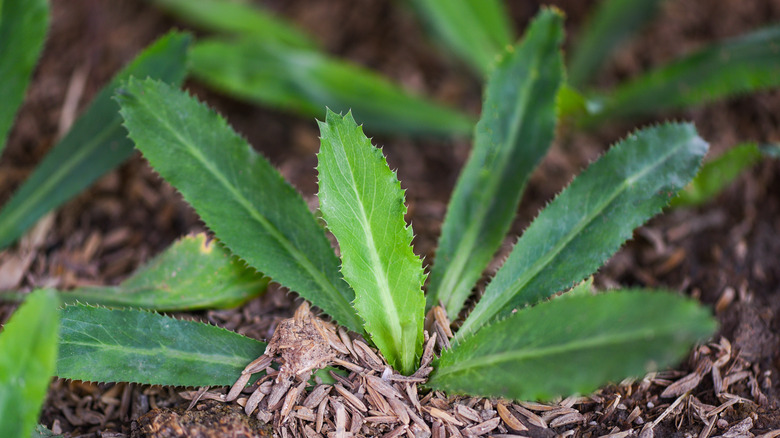What Is Culantro And What Does It Taste Like?
Before we get started here, let's clear one thing up: there is no typo in the headline of this piece. If you're reading this because you thought we made a slip of the keyboard and actually meant to write "cilantro," you will be disappointed if you read any further. Yes, culantro, or Eryngium foetidum, as it's known in the science world, is a relative of the leafy herb that flavors the rice in your burrito bowl from Chipotle, and, as it turns out, the two are comparable when it comes to taste (via The Spruce Eats). However, the methods of employing culantro in the kitchen are different than its soap-flavored cousin, not to mention that the two are complete opposites when it comes to their looks.
Before we keep going, we're going to once again warn you that we're going to be talking about culantro with a "u," not cilantro. If you actually came here to learn about the ingredient that's often found in Caribbean cuisine, or didn't but are a little intrigued by it now, we hope you find this guide helpful for all of your culinary endeavors.
What is culantro?
Culantro – again, with a "u" – is an herb that is native to Mexico, Central, and South America, though Serious Eats notes that it can be grown just about anywhere the boasts a tropical climate. While not exactly a common ingredient in the United States, culantro is a major player in the cuisine from the aforementioned regions, and in many Asian dishes as well. However, it may go by a different name depending on where it's found. For example, The Spruce Eats explains that culantro is typically referred to as recao in Puerto Rico, where it is often used in sofrito, whereas certain parts of the Caribbean call it chandon beni.
Culantro is a member of the Apiaceae family, making it a relative of celery, carrots, and, yes, cilantro, though you won't have any trouble deciphering between the two herbs when it comes to their looks. This pungent ingredient has long, wide, and serrated leaves that can grow similarly to lettuce in a rosette formation and can get up to a foot tall. Its nearly phonetically identical cousin, on the other hand, is long and thin with small leaves sprouting out from the top.
What does culantro taste like?
If you're hoping to find a substitution for cilantro that will be easier on your tastebuds, we hate to break it to you, but culantro isn't your answer. In fact, The Spruce Eats writes that the jagged-toothed herb is said to be 10 times stronger than its highly controversial cousin and produces an odor that resembles "crushed stinkbugs." Therefore, if you're like Ina Garten and have been cursed with the gene that causes cilantro to take on a strong, soapy flavor, you'll definitely want to take a hard pass on culantro when you see it at the grocery store.
However, for those that are on the opposite side of the cilantro debate, culantro may right up your alley. Described by one chef as having an "herby, citrusy taste" and by Serious Eats as having a slight "pepperiness" when eaten raw, this pungent ingredient adds some serious flavor to a number of dishes including chutneys, soups, and meat marinades (via Fine Dining Lovers).
How to cook with culantro
Culantro's intense flavor may be a turn-off for some, but this aspect of the herb also gives it more uses in the culinary world. Sure, you could chop up a few of its serrated leaves to use as a garnish on your tacos, or even use it as a replacement for cilantro in a batch of guacamole, so long as you make sure to cut down on the amount to make up for its stronger taste. However, Serious Eats notes that more often than not, culantro is actually cooked rather than eaten raw since its potency gives it the ability to withstand the heat without the threat of turning bitter or losing its flavor completely.
As a rule of thumb, Fine Dining Lovers advises utilizing culantro to "bring out the flavor of the foods." Try adding it to the pan when sauteing garlic and onions, or throwing it into a pot of rice or beans. And if you're want to try culantro in a more traditional way, this Puerto Rican sofrito recipe from Sense & Edibility might be a great place to start.
Nutritional information about culantro
On top of bringing some serious flavor to a number of dishes, culantro also has the added benefit of containing several vitamins and nutrients. Similar to cilantro, this herb is a source of iron, calcium, and vitamins A and C (via Grow Herbs Garden). However, unlike its distant cousin, culantro is also a source of carotene, riboflavin, and Vitamin B-complex. More specifically, culantro is high in vitamins B1 and B2, the latter of which can help with lowering blood sugar levels and managing diabetes.
Culantro is also said to have many medicinal properties and was traditionally employed to help combat a number of ailments including fevers, vomiting, and diarrhea (via Purdue University). Its leaves were often boiled and incorporated into a tea drink that was said to help cure sicknesses such as pneumonia and the flu. Per Grow Herbs Garden, this is also the best method to use to benefit from culantro's anti-inflammatory and pain relief properties, which research shows that it gets due to the presence of phytochemicals, and also happens to be another one of the herb's parallel's to cilantro (via NCBI and Healthline). According to Nutritional Diversity, there is also evidence that culantro roots can be an effective treatment for snake bites or scorpion stings.
How to buy, grow, and store culantro
Unfortunately, culantro isn't as easily accessible in the United States as it may be in places where it is a key ingredient in the cuisine. You may not be able to find it in the produce section of your regular grocery store, though a specialty market may have it in stock.
If you do happen to run into trouble finding a place to purchase culantro, you also have the option to grow it yourself at home. According to Bonnie Plants, the method of growing this herb is similar to that of lettuce in that it should be started in the spring after the final frost. Make sure to plant it in a partially shaded area as well to prevent it from flowering too early.
Whether you've plucked culantro from your garden or purchased them from the store, unused leaves should be stored in the same way. Per The Spruce Eats, wrap your herbs in a damp paper towel and placing them in a plastic bag before stowing them away in the refrigerator, where they can last for up to a week.
